It looks like you're using an Ad Blocker.
Please white-list or disable AboveTopSecret.com in your ad-blocking tool.
Thank you.
Some features of ATS will be disabled while you continue to use an ad-blocker.
share:
I would venture a guess that the "beads" making up the trails are solidified hot magma that surfaced following a stress fracture of the surface.
Similar to how blood upwells within a cut when you scratch yourself.
Originally posted by dtrock78
I'm willing to bet, there is a large impact crater on the moon fairly close to where these "lines'.
These "lines" are inside a 15 km wide crater, on the wall of the crater, as you can see if you look at the whole image.
Originally posted by ArMaP
Originally posted by dtrock78
I'm willing to bet, there is a large impact crater on the moon fairly close to where these "lines'.
These "lines" are inside a 15 km wide crater, on the wall of the crater, as you can see if you look at the whole image.
Yes....and just read the caption:
"Southwest of Rowland crater on the Moon's farside, a 15 km diameter unnamed crater exhibits many boulder trails on the crater walls. The boulders range from 1 m to 15 m across and mark a path downslope to the crater floor from a higher elevation."
What again is the mystery here?
Originally posted by nv4711
Originally posted by ArMaP
Originally posted by dtrock78
I'm willing to bet, there is a large impact crater on the moon fairly close to where these "lines'.
These "lines" are inside a 15 km wide crater, on the wall of the crater, as you can see if you look at the whole image.
Yes....and just read the caption:
"Southwest of Rowland crater on the Moon's farside, a 15 km diameter unnamed crater exhibits many boulder trails on the crater walls. The boulders range from 1 m to 15 m across and mark a path downslope to the crater floor from a higher elevation."
What again is the mystery here?
The detail that can be observed in the enhanced images does not agree with the image description.
Originally posted by arianna
The detail that can be observed in the enhanced images does not agree with the image description.
To me it does, if you understand that the enhancement doesn't change things, so a crater is still a crater and a rock is still a rock.
The tracks still look like tracks made by boulders, even after the enhancements, and if you see things differently then it means (in my opinion) that your perception of what you see in the photos is changed when you look at an image with more contrast.
Originally posted by ArMaP
Originally posted by arianna
The detail that can be observed in the enhanced images does not agree with the image description.
To me it does, if you understand that the enhancement doesn't change things, so a crater is still a crater and a rock is still a rock.
The tracks still look like tracks made by boulders, even after the enhancements, and if you see things differently then it means (in my opinion) that your perception of what you see in the photos is changed when you look at an image with more contrast.
Firstly, the camera doesn't lie. The original image provided by NASA at al in my professional opinion is not the true original as captured by the camera onboard the orbiter. The original should appear close to what can be observed in the enhancements but would probably have been slightly lighter with better graduation of greyscale. A photo-enhancement of an image does change things as can be seen from the images posted in this thread. The shadow-enhancement procedure, when carefully controlled, does not introduce additional detail but reveals detail which may normally be 'hidden', 'washed out' or 'flat' as can be viewed in the above original.
In answer to the tracks and boulders I am going to stick my neck out here and strongly disagree with you. The objects that appear as tracks and boulders are in fact built structures. I have been researching surface detail on Mars and the Moon for a great number of years and feel confident and qualified enough to say that I know what I am talking about when it comes to interpreting what can be seen in an aerial image. With respect, your last sentence is not correct. Perception of what is contained in an image that has good definition and a low contrast level can be just as revealing to a seasoned observer as an image that displays a high level of contrast.
That's true.
Originally posted by arianna
Firstly, the camera doesn't lie.
So, the camera doesn't lie, but as you don't believe in this photo, it means this is not the original...
The original image provided by NASA at al in my professional opinion is not the true original as captured by the camera onboard the orbiter. The original should appear close to what can be observed in the enhancements but would probably have been slightly lighter with better graduation of greyscale.
Why do you think that the image should look more like the enhancements? In which do you base your interpretation? And why do you say "in my professional opinion"?
It's obvious it changes things, if it wouldn't nobody would use them.
A photo-enhancement of an image does change things as can be seen from the images posted in this thread.
What I meant is that it doesn't change the objects or the relative sizes and/or positions, only the way they look.
My problem with these enhancements is not what they add, it's what they remove, and in this case (as in most uses of any "enhancements") it removes detail, so saying we see things better with less detail is not really true, we are seeing the same things with less detail, so they look slightly different.
The shadow-enhancement procedure, when carefully controlled, does not introduce additional detail but reveals detail which may normally be 'hidden', 'washed out' or 'flat' as can be viewed in the above original.
OK, could you explain why do you think that, what, on the original photo, makes you think of it? As for what you see on the "enhanced" image, seeing that you were the one doing the changes in the photo, how can you know if you weren't doing things to see what you wanted to see?
The objects that appear as tracks and boulders are in fact built structures. I have been researching surface detail on Mars and the Moon for a great number of years and feel confident and qualified enough to say that I know what I am talking about when it comes to interpreting what can be seen in an aerial image.
Perception of what is in a picture depends on the person looking at it, the perception is a human feature, not a photo property; in the same way as a colour-blind person would have a different perception of a painting, for example, some people may have different perceptions when looking at more or less contrasted images.
With respect, your last sentence is not correct. Perception of what is contained in an image that has good definition and a low contrast level can be just as revealing to a seasoned observer as an image that displays a high level of contrast.
Another thing we should always remember is that we are not looking at a photo, we are looking at a reproduction of a photo on our computer's screens, so we may really be looking at different things, if the monitors are not well adjusted.
reply to post by arianna
To me it appears to be an arial view of a town I'm looking at, but is there anything specific I'm supposed to see?
To me it appears to be an arial view of a town I'm looking at, but is there anything specific I'm supposed to see?
I think it's a landslide.
Originally posted by arianna
A very large object is resting on the rim of the crater. Is this object part of a crashed spacecraft?
I went looking for more photos of that area, and found two more photos that show that "feature". There's at least another photo, but the "feature" is in the shadow and not much visible.
The first photo suffers from too much JPEG artefacts, and both images were changed to greyscale before adjusting levels, to avoid the colour noise resulting from the process, and because colour is not needed for this.
Photo AS17-151-23172
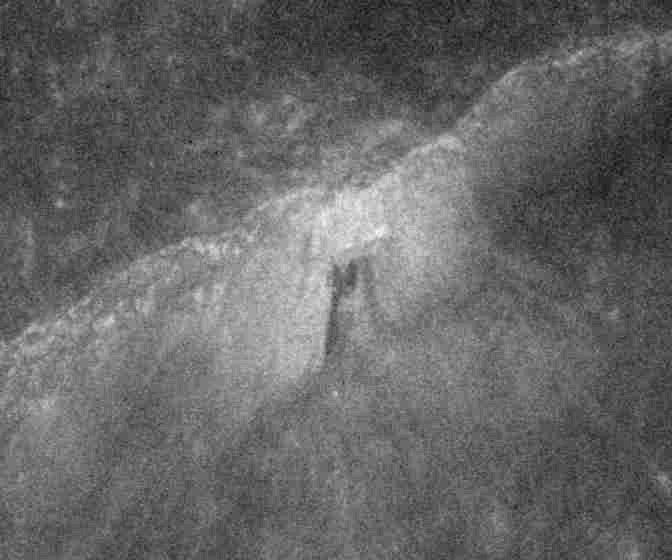
Photo AS16-121-19407
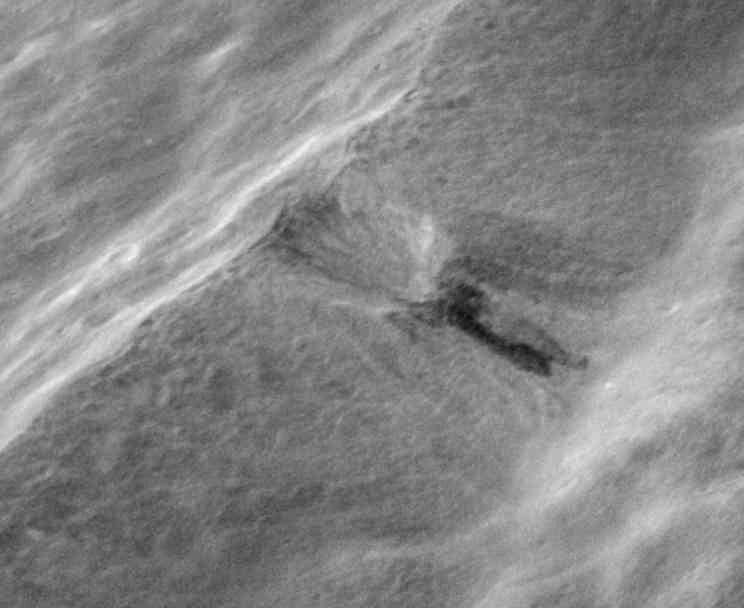
reply to post by ArMaP
I cannot see how this location is the same location as the spacecraft anomaly shown above but there are some very interesting features showing in the enhancement.
Here is an enhancement of AS17 - 151 - 23172.

I cannot see how this location is the same location as the spacecraft anomaly shown above but there are some very interesting features showing in the enhancement.
Here is an enhancement of AS17 - 151 - 23172.

The image you posted was from photo AS17-150-23086 (although you forgot the "150"), and you can see in the map below the area that was captured in the photo.
Originally posted by arianna
I cannot see how this location is the same location as the spacecraft anomaly shown above but there are some very interesting features showing in the enhancement.
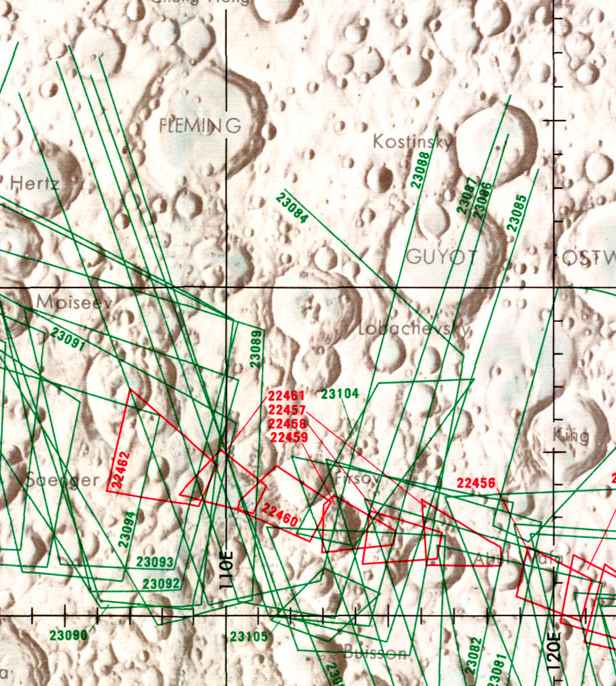
Knowing the location, I only had to look for other photos that covered the same area. One of the photos that cover that area is photo AS17-151-23172, as you can see in the next map.
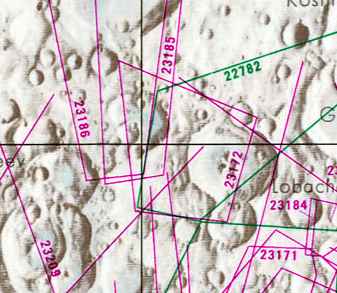
Other photo is photo AS16-121-19407, shown in the map below.
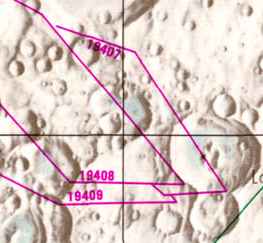
Looking at some characteristics you can see that the three photos show the same area.
(click for full size)
AS17-150-23086
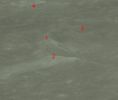
AS17-151-23172
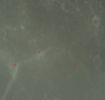
AS16-121-19407

Now that you have several photos that show the same area you can see if what you see in your enhancements appear in all photos or not.
PS: the maps are available here.
edit on 6/11/2011 by ArMaP because: (no
reason given)
The image AS16-121-19407 is not the same view as the image of the spacecraft anomaly shown above.
It is a view of the the anomalous feature on the rim of Guyot crater which has attracted much interest by members of the scientific community.
Here is an enhancement of the view which was cropped from the full-size tiff image. The view shown here is 600 pixels wide and the direct view is 1000 pixels wide. There are objects in the image which tend to indicate the presence of life activity in the past. Whether there is still life activity on the surface cannot be determined.
Do you notice anything specific about the content in the image?

Direct link: i985.photobucket.com...
It is a view of the the anomalous feature on the rim of Guyot crater which has attracted much interest by members of the scientific community.
Here is an enhancement of the view which was cropped from the full-size tiff image. The view shown here is 600 pixels wide and the direct view is 1000 pixels wide. There are objects in the image which tend to indicate the presence of life activity in the past. Whether there is still life activity on the surface cannot be determined.
Do you notice anything specific about the content in the image?

Direct link: i985.photobucket.com...
edit on 7-11-2011 by arianna because: added
text
reply to post by arianna
"Specific"? Yes, it is specifically the Moon.
Taken over 40 years ago, and not particularly high resolution. I see a ridge (taking your word for it being a portion of a crater wall). Subsequent to that crater's formation, and the resulting ridge, a smaller object made another impact crater, that happened to hit on the rim of the large crater.
The shadows, and the light areas, clearly give clues as to the angle of the Sun, at time the photo was taken.
Since there is not a lot of sharp detail, the general contours are rough, but typical of the Moon, and having the oblique view (rather than one straight down from above) gives a sense of 3D quality that is lacking from a strictly top-down photo.
Do you notice anything specific about the content in the image?
"Specific"? Yes, it is specifically the Moon.
Taken over 40 years ago, and not particularly high resolution. I see a ridge (taking your word for it being a portion of a crater wall). Subsequent to that crater's formation, and the resulting ridge, a smaller object made another impact crater, that happened to hit on the rim of the large crater.
The shadows, and the light areas, clearly give clues as to the angle of the Sun, at time the photo was taken.
Since there is not a lot of sharp detail, the general contours are rough, but typical of the Moon, and having the oblique view (rather than one straight down from above) gives a sense of 3D quality that is lacking from a strictly top-down photo.
The last poster is correct. The image was captured 40 years ago when personal computers were non-existent..The prominent 'ridge' is the rim of the
crater.
Disregarding the enhancement procedure applied to the image, do you feel that the image has been amended in any way to diffuse the content?
Disregarding the enhancement procedure applied to the image, do you feel that the image has been amended in any way to diffuse the content?
edit on 7-11-2011 by arianna because: (no reason given)
edit on 7-11-2011 by arianna because: added text
reply to post by arianna
No. Not sure what the implication is. You sourced it from an "ImageShack" site, so not sure what anyone might have done to it, before hosting it there.
Instead, here it is on the NASA gallery site:
spaceflight.nasa.gov...
A brief description is included:
I emphasized the last sentence in the snippet, because it seemed to the the focus of interest in that particular photo.
It is perfectly ordinary in all other aspects.
Disregarding the enhancement procedure applied to the image, do you feel that the image has been amended in any way to diffuse the content?
No. Not sure what the implication is. You sourced it from an "ImageShack" site, so not sure what anyone might have done to it, before hosting it there.
Instead, here it is on the NASA gallery site:
spaceflight.nasa.gov...
A brief description is included:
An oblique view of a rim of Guyot Crater on the lunar farside, as photographed from the Apollo 16 spacecraft in lunar orbit. The coordinates of the center of Guyot Crater are 116.5 degrees east longitude and 10.5 degrees north latitude. Note the black coloration which appears to be lava flow down the side of the crater rim.
I emphasized the last sentence in the snippet, because it seemed to the the focus of interest in that particular photo.
It is perfectly ordinary in all other aspects.
According to the map, that photo doesn't show Guyot crater, so someone (you, me or NASA) is wrong.
Originally posted by arianna
The image AS16-121-19407 is not the same view as the image of the spacecraft anomaly shown above.
It is a view of the the anomalous feature on the rim of Guyot crater which has attracted much interest by members of the scientific community.
No.
Do you notice anything specific about the content in the image?
Originally posted by ArMaP
According to the map, that photo doesn't show Guyot crater, so someone (you, me or NASA) is wrong.
Originally posted by arianna
The image AS16-121-19407 is not the same view as the image of the spacecraft anomaly shown above.
It is a view of the the anomalous feature on the rim of Guyot crater which has attracted much interest by members of the scientific community.
There have been some captions that identify this as the wrong crater. It's not Guyot Crater, but rather Lobachevsky Crater.
The dark streaks in your image (as seen here)...

...has been a topic of interest before.
Some say it is a shadow, others say it is dark soil caused by a lava flow, or possibly darker soil that broke of from the rim of that small crater above it.
edit on 11/8/2011 by Soylent Green Is People because: (no reason given)
The area shown in the image above is not the same location for the 'spacecraft' anomaly.
The crater where the 'spacecraft' anomaly is situated is given as FIRSOV but is it situated on the rim of Firsov or another crater? Very confusing to say the least!

The crater where the 'spacecraft' anomaly is situated is given as FIRSOV but is it situated on the rim of Firsov or another crater? Very confusing to say the least!

edit on 8-11-2011 by arianna because: (no reason
given)
new topics
-
How To Spot Fake U.F.O. Photos
Aliens and UFOs: 10 hours ago
top topics
-
LA Mayor Bass Demanded $49M in Additional LAFD Cuts One Week Before Wildfires
Mainstream News: 16 hours ago, 17 flags -
Just Came Across These Unusual Old UFO Pics
Aliens and UFOs: 14 hours ago, 7 flags -
Scary video of face in an abandoned house
Paranormal Studies: 12 hours ago, 5 flags -
How To Spot Fake U.F.O. Photos
Aliens and UFOs: 10 hours ago, 5 flags -
Carry On!
Short Stories: 17 hours ago, 3 flags -
Sepultura - Territory - With New Drummer Greyson Nekrutman
Music: 17 hours ago, 3 flags
active topics
-
Trump says ownership of Greenland 'is an absolute necessity'
Other Current Events • 166 • : Lazy88 -
Gravitic Propulsion--What IF the US and China Really Have it?
General Conspiracies • 40 • : Lazy88 -
Judge rules president-elect Donald Trump must be sentenced in 'hush money' trial
US Political Madness • 122 • : JadedGhost -
Fire insurance in LA withdrawn months ago
General Conspiracies • 39 • : Flyingclaydisk -
Los Angeles brush fires latest: 2 blazes threaten structures, prompt evacuations
Mainstream News • 395 • : Flyingclaydisk -
Archbisop Vigano Warns of Deep State and Deep Church
New World Order • 12 • : FlyersFan -
This should be plastered all over the airwaves
Mainstream News • 56 • : Flyingclaydisk -
Oh, Good Gosh. “Kremlin Warns Stay Away from Greenland.”
World War Three • 33 • : Dalamax -
How To Spot Fake U.F.O. Photos
Aliens and UFOs • 4 • : SteamyAmerican -
Just Came Across These Unusual Old UFO Pics
Aliens and UFOs • 6 • : NoCorruptionAllowed
